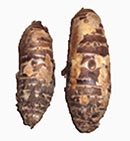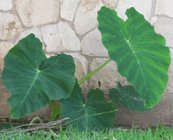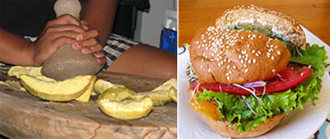Taro root Nutrition facts
Taro is a starch-rich, globular fleshy taproot of aroid family plants. Its underground root, known as a corm, is one of the traditional edible root vegetables to the greater parts of Asia, the Pacific islands, West Africa, and the Amazonian regions of South America. Some of the common names are cocoyam, dasheen, Colocasia, elephant’s ear plant, amadumbe, kalo,, etc.
Binomially, it belongs to the Araceae (aroid) family, in the large genus, Colocasia.
Scientific name: Colocasia esculenta (L.) schott.
 |

|
| Dasheen roots, popular as kalo in the Pacific islands. | Dasheen (Taro) plant (C.esculenta var.esculenta) Courtesy:IngaMun. |
Taro is a large perennial herbaceous plant growing up to 5-6 feet. Its rather large heart-shaped, frilly-edged leaves at the end of long, stout petioles appear like an elephant’s ear. It grows best in marshy, wet soil and warm, humid climates.
The corm grows to a size of a turnip, and has a globular or oblong shape with brown, tough skin. Its surface is marked by circular rings indicating points of attachment of scaly leaves. Inside, its flesh is white to cream-yellow but may feature different colors depending upon cultivar type. An average-size corm weighs about 2-4 pounds. Its delicious, crispy-textured meat becomes soft and edible once cooked and has a nutty flavor just as in water chestnuts.
Yautia (Xanthosoma species), also known as tannia, malanga, etc., is similar to taro but smaller and has somewhat elongated, bumpy corms that are grown widely in East Asia, Caribbean and South American regions.
Eddoe (Colocasia esculenta antiquorum) is also a smaller corm with an irregular surface. It grows widely in India, China, and Japan as well as in some Caribbean countries. It is known as arbi in the Indian subcontinent.
Health benefits of Taro
Taro or dasheen roots carry more calories than potatoes. 100 grams of root provides 112 calories. Their calorie value chiefly comes from complex carbohydrates, amylose, and amylopectin. However, they are a minor source of fats and protein than in cereals and pulses. Their protein levels can be comparable to that of other tropical food sources like yam, cassava, potato, plantain, etc.
The corms, however, are free from gluten protein. They carry a high-quality phytonutrient profile comprising of dietary fiber, and antioxidants in addition to moderate proportions of minerals, and vitamins.
Taro is one of the finest sources of dietary fibers; 100 g of flesh provides 4.1 g or 11% of the daily requirement of dietary fiber. Together with slow-digesting complex carbohydrates, moderate amounts of fiber in the food help a gradual rise in blood sugar levels.
Yellow-fleshed roots and young, tender leaves have significant levels of phenolic flavonoid pigment antioxidants such as ß-carotenes, and cryptoxanthin along with vitamin-A. 100 g fresh taro leaves provide 4825 IU or 161% of RDA of vitamin A. Altogether, these compounds are required for maintaining healthy mucosa, skin, and vision. Consumption of natural foods rich in flavonoids helps protect from lung and oral cavity cancers.
It also contains good levels of some of the valuable B-complex group of vitamins such as pyridoxine (vitamin B-6), folates, riboflavin, pantothenic acid, and thiamin.
Further, the corms provide healthy amounts of some of the essential minerals like zinc, magnesium, copper, iron, and manganese.
Besides, the root has good amounts of potassium. Potassium is an essential component of cells and body fluids that help regulate heart rate and blood pressure.
| Principle | Nutrient Value | Percent of RDA |
|---|---|---|
| Energy | 112 Kcal | 6% |
| Carbohydrates | 26.46 g | 20% |
| Protein | 1.50 g | 3% |
| Total Fat | 0.20 g | <1% |
| Cholesterol | 0 mg | 0% |
| Dietary Fiber | 4.1 g | 11% |
| Vitamins | ||
| Folates | 22 µg | 5.5% |
| Niacin | 0.600 mg | 4% |
| Pantothenic acid | 0.303 mg | 6% |
| Pyridoxine | 0.283 mg | 23% |
| Riboflavin | 0.025 mg | 2% |
| Thiamin | 0.095 mg | 8% |
| Vitamin A | 76 IU | 2.5% |
| Vitamin C | 4.5 mg | 7% |
| Vitamin E | 2.38 mg | 20% |
| Vitamin K | 1 µg | 1% |
| Electrolytes | ||
| Sodium | 11 mg | <1% |
| Potassium | 591 mg | 12.5% |
| Minerals | ||
| Calcium | 43 mg | 4% |
| Copper | 0.172 mg | 19% |
| Iron | 0.55 mg | 7% |
| Magnesium | 33 mg | 8% |
| Manganese | 0.383 mg | 1.5% |
| Selenium | 0.7 µg | 1% |
| Zinc | 0.23 mg | 2% |
| Phyto-nutrients | ||
| Carotene-ß | 35 µg | -- |
| Carotene-α | 0 µg | -- |
| Cryptoxanthin-ß | 20 µg | -- |
| Lutein-zeaxanthin | 0 µg | -- |
Selection and storage
To harvest, the whole plant is pulled off the ground about 8-10 months after plantation when its leaves begin to turn yellow. In the tropics, fresh corms can be readily available in the markets. In fact, taro has a cultural identification with many Asia-Pacific societies. Each year Hawaiians celebrate the annual taro food festival in April when their children learn to pound taro to make poi (a kind of taro paste). Farmers carry their fresh harvest to gift friends, and relatives.
Cleaned and processed taro corms can be available in the US markets usually imported from the Pacific islands. Buy fresh, firm, medium-size hairy corms that feel heavy in hand for their size. Avoid those with soft spots, cracks, or sprouts at scales.
Fresh corms should be stored in cool, dark, well-ventilated places as in potatoes, yams, etc. Do not keep them inside the refrigerator as they could sustain a chilling injury. Taro greens, however, should be placed in the refrigerator and used in a way like other greens.
Preparation and serving methods
 , and Taro burger in Honolulu. Photo courtesy: janineomg , and Taro burger in Honolulu. Photo courtesy: janineomg |
Raw taro corms and leaves can be unpleasantly bitter and harmful to health and, therefore should be processed and boiled before consumption. However, the plant parts are very safe after being cooked (boiling, frying, steaming, etc.).
To prepare, wash the corm, trim the ends, and peel away its outer tough hairy skin using a paring knife. Place its white interior flesh in cold water to remove sticky sap.
Here are some serving tips:
The corm taro can be used in a variety of preparations. In Hawaii, boiled root is ground into a sticky paste known as poi.
Kaulau, a traditional Polynesian coconut pudding dessert in which, boiled dasheen is mixed with coconut milk and brown sugar.
The corms are also employed in the preparations of burgers, bread, flakes, pancakes, muffins, chips, flour, cookies, ice cream, etc.
Taro leaves used in soups, pakora (known as pathrode in some parts of coastal South India).
Safety profile
All of the taro plant parts including corms contain oxalic acid which renders them acrid. Fortunately, however, this chemical is entirely destroyed in cooking. Cooked taro is safe for human consumption. (Medical-disclaimer).
≺≺ Also read- Malanga (yautia) nutrition facts and health benefits.
≺≺ Back to Vegetables from Taro nutrition. Visit here for an impressive list of vegetables with complete illustrations of their nutrition facts and health benefits.
≺≺ Back to Home page.
Further reading: